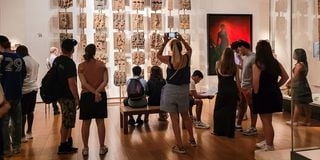Visiting the most visited museum in the world

After enjoying almost two weeks of a holiday visiting relatives and friends in picturesque and quiet villages in the green and hilly country of south-west England, Lut and I decided to spend our last full day in a more urban and fast-moving place – London. We went to Bloomsbury, a district of the city I knew quite well in my younger years before Kenya captivated me. It is still a fashionable district, with many cultural and educational institutions, but much livelier and noisier than I remember it.
Our main aim in going there was to visit the British Museum, the most prestigious of those cultural and educational institutions. And the main reason was because I thought there was an interesting story to be told.
As you will know, the British Museum stores and exhibits a great number of artifacts carried back to England by explorers, soldiers, missionaries, administrators, and archaeologists in the many years of British empire building. These days, several countries want back some of these artefacts to be placed in their own museums – precious works of art such as the Greek Elgin Marbles and the Benin Bronzes. One of the reasons given for not agreeing to these requests is that, kept in the British Museum, they are in a highly secure place. Well, this argument has recently been dented somewhat, because the museum has suffered a most embarrassing theft.
In 2020, Dr Ittai Gradel, a Danish antiquities dealer, began to suspect that an eBay seller he had been buying from was a thief who was stealing from the British Museum. He expressed his concern to senior staff at the museum, who, at first, didn’t take the matter seriously. However, two years later, the museum reported that thousands of objects were missing, stolen or damaged from its collection.
After investigations, it was found that many items had been stolen from a storeroom in the Greece and Rome department by a senior curator, Dr Peter Higgs. More than two million items at the museum were uncatalogued, out of its total collection of eight million. Dr Higgs had been targeting these uncatalogued artefacts – mainly small and engraved gemstones or cameos – and it was found that 1,161 items were missing. Dr Higgs was dismissed in July 2023, and the museum has brought a civil case against him in the High Court. The FBI is also involved, in tracing stolen items in the United States.
About the place of the British Museum in the hierarchy of museums, its permanent collection of eight million artefacts makes it the largest museum in the world – telling the human story from the beginning to the present. Founded in 1753, it is also the oldest national public museum. When it opened its doors six years later, it invited in ‘all studious and curious persons’; now it is open to all, and entrance is free.
The museum’s extensive and excellent website says, ’The British Museum is unique in bringing together under one roof the cultures of the world, spanning continents and oceans. No other museum is responsible for collections of the same depth, breadth, beauty, and significance.
It is also on record as the world’s most-visited museum. Nevertheless, when we were there last Tuesday, we were amazed at the number of people – mostly from East Asia countries – who swarmed around the galleries, exhibitions, cafés and shops. I have checked the figures and found that the museum had 5,820,860 visitors in 2023.
Divided by 361 – since the museum is open every day except for four days over the Christmas period – that makes a daily average of 16,124 – more than the 15,000 capacity of the Nyayo Stadium.
The short profile of London shown on British Airways’ entertainment programme, says that it would take about a year to visit all the interesting places that London has to offer; I reckon it would take more than a lifetime to study all that the British Museum has to offer. Our own ambition was limited to visiting only the Africa Gallery – to see and not to study!
What Zeinab Badawi tells in words in her recent book, An African History of Africa, the gallery shows in artefacts – the astonishing cultural, artistic and historical diversity of Africa. The display includes examples of metalwork, textiles, clothes, pottery, tools and sculpture. They are illustrative of themes such as trade, identity, gender, power, religion and governance. There are also some striking contemporary works of art, including some by African artists living outside the continent.
On the day we were there, it was the display of Benin Bronzes that was attracting the most attention. Discussions are underway with the relevant agencies about the formal request made for their return to Nigeria. Compared with national museums, the British Museum has the clear advantage that it is one place – and a much-visited place – with artefacts to be seen and studied from all over the world. Nevertheless, it is seriously engaged in dialogue with several nations about schemes of exchange exhibitions and loans of items, as well as their permanent return.
John Fox is the Chairman of iDC. Email: [email protected]





